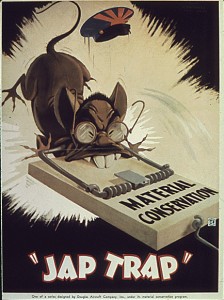
“Jap Trap,” World War II propaganda poster, United States Information Service, 1941–45. Densho Digital Archive, http://www.densho.org/.
“Propaganda can tip the scales,” claims Schivelbusch in regards to state influence in times of political turmoil in his Three New Deals. (85) The usual dialogue on the topic of interwar propaganda mostly elicits imagery associated with the USSR and Nazi regime, but what about the propaganda and control by the United States government? This is an example:
This blatantly racist imagery not only compares the Japanese to rats, it also depicts the rat with the physical stereotypes American’s gave the Japanese during the time. The squinted eyes, protruding teeth, and cartoonishly animated circular spectacles reappeared throughout anti-Japanese propaganda. The simple process of dehumanization of the enemy through animation also appears commonly in the anti-semitic propaganda perpetuated by the Nazis.
The Nazis as well as America assimilated the rat with their enemies. Rats are grotesque, parasitic, and carry disease. Essentially, they are an animal no one loves. It is certainly easier to identify propaganda that is new or foreign, however, after those images are presented repeatedly they become automatically associated with the intended concept and sink into the subconscious. This, in effect, is what makes it so powerful.
If an audience is being persuaded without realizing, can they stop it?

